How to Use Edit Toolpath - Replace
Introduction
This example explains how to use the Replace option in the Edit Toolpath dialog box.The Replace command mode will allow you to substitute wireframe and/or edge geometry for existing toolpath elements.The example provided will have you:
- Viewing the Toolpath
- Opening the Edit Toolpath Dialog Box
- Setting the Command Mode
- Selecting Toolpath Elements
- Setting the Toolpath Chain
- Adjusting the Results
- Executing the Action
- Viewing the Animation
- Exiting the Edit Toolpath Dialog
Example Part
If you are connected to the Internet, the part file for this example can be downloaded automatically by clicking the following link: Toolpath_Editor_Replace_Example.bbcd
Once you download and saved the zip file, extract the files on your system in an easy place to remember.You can then open the file to use with this tutorial.All files for the tutorials in this help system available for download can be found by clicking on the following link: http://www.bobcad.com/helpfiles.
In the example file provided, the stock and MachineSetup are already defined for the part, and the toolpath to be adjusted has been applied.
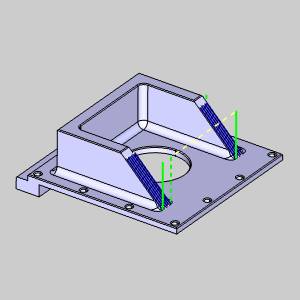
Part 1) Viewing the Toolpath
On our example part, we have created an Advanced Planar toolpath, and have used boundaries to isolate it on the angled surfaces of our part.In this case, the toolpath has been separated into two separate regions, and those regions are connected with a rapid.It is this rapid we will replace with a feed move that traces around the inner fillet in the direction seen below.
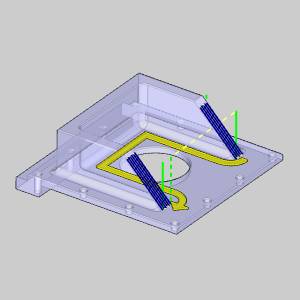
- In the CAM Tree, click the
 Advanced Planar operation of the
Advanced Planar operation of the Feature 3 Axisto highlight the toolpath in the graphics area.
Feature 3 Axisto highlight the toolpath in the graphics area.
Take a moment to look at the existing linking between toolpath regions to see what we intend to accomplish.
Part 2) Opening the Edit Toolpath Dialog Box
The Edit Toolpath function is only applied to individual operations, as such, the first step is always to right-click on the operation to be adjusted.
-
Right-click the
 Advanced Planar operation of the
Advanced Planar operation of the Feature 3 Axis.
Feature 3 Axis. -
Select Edit Toolpath.
TheEdit Toolpath dialog appears.
Part 3) Setting the Command Mode
The Edit Toolpath dialog gives you access to eight different CommandModes.For this example, we will be utilizing the Replace Command Mode.
-
Click the arrow on the Command Mode list to view the list items.
-
Select the Replaceoption.
-
By default, the Previewcheck box is already selected.Leave this check box selected, as it will allow us to see a preview of the executable result, once our Toolpath Chain has been confirmed.
Part 4) Selecting Toolpath Elements
Select the toolpath to be edited.
-
In the graphics area, zoom into the area shown in the image below.
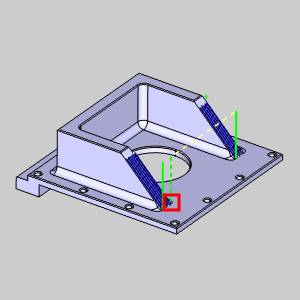
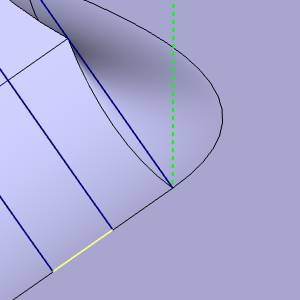
-
Hover over the lower portion of the retract move and click on the toolpath element shown below.
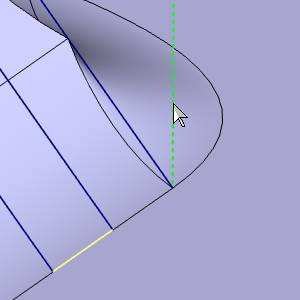
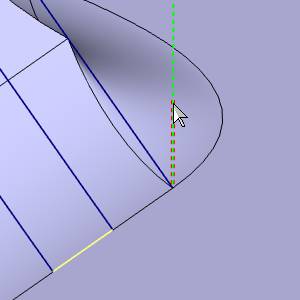
Important: If the toolpath elements that highlights is not the first move of the rapid, as in the image below, be sure to include the first toolpath element in your selection as well.
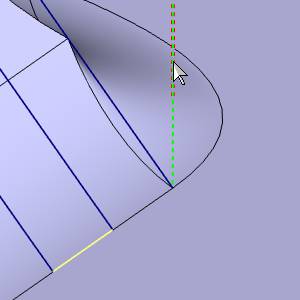
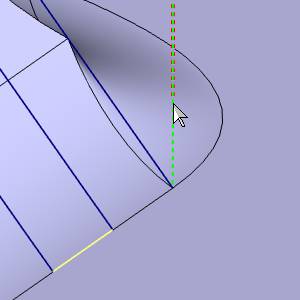
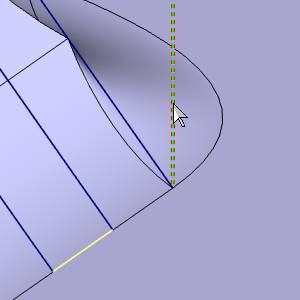
-
Zoom out in order to bring the entire model back into view.

-
Now, zoom into the area shown in the image below.
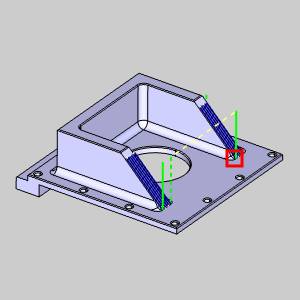
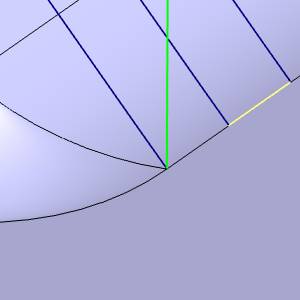
-
Move your mouse to the end of the green toolpath element.
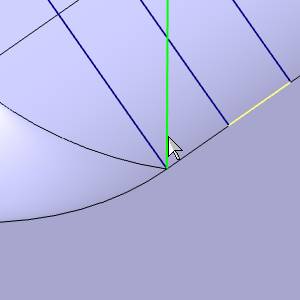
-
Press and hold Shift and click the bottom of the toolpath element to perform a chain selection of all the toolpath elements between.
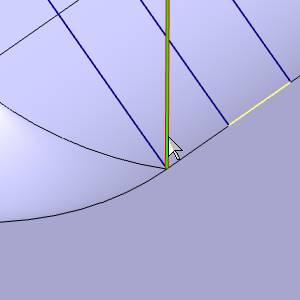
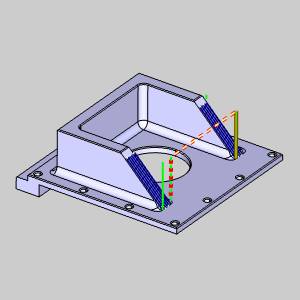
Part 5) Setting the Toolpath Chain
With the toolpath elements selected, we will need to set the Toolpath Chain to define the new path of the toolpath elements.
-
In the Parametersgroup, click the Pick button to begin selecting the Toolpath Chain.
-
Select the five individual edges on the model, as shown in the images below.
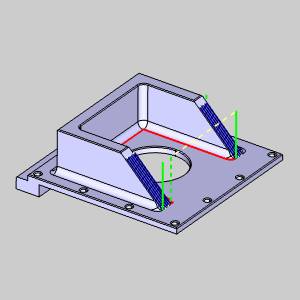
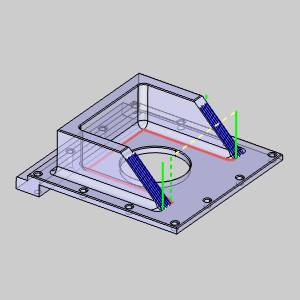
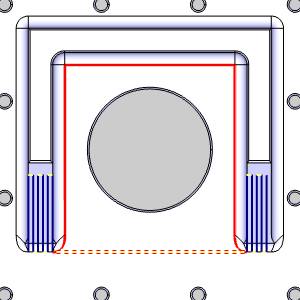
-
With the five edges selected, right-click and select
 OK.
OK.
The executable preview displays.
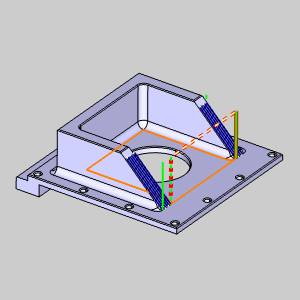
Part 6) Adjusting the Results
In some cases, depending on the direction of the Toolpath Chain, the preview may show an unintentional result, as shown in the image below.In these cases, we would need to Reverse Direction.
-
In the Toolpath Chain list, click on Chain 1 to highlight it.
The Chain highlights and shows directional arrows.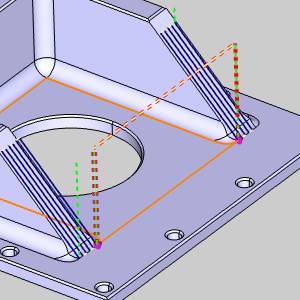
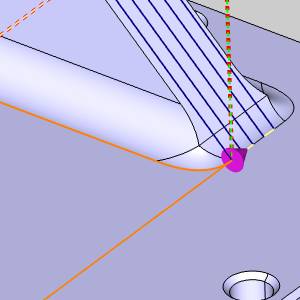
-
Right-click Chain 1 in the Toolpath Chain list and select Reverse Direction if the chain is not moving in the X negative direction.
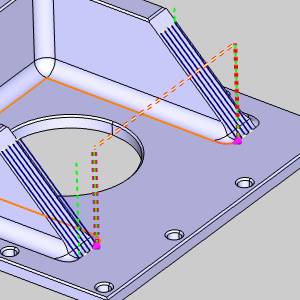
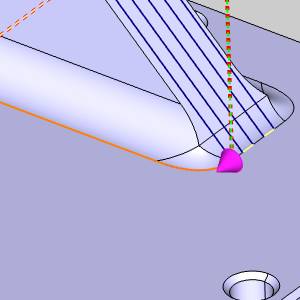
The preview updates if the chain is reversed.
Part 7) Executing the Action
To move beyond the preview, and before clicking OK to finalize and exit, it is a good idea to Execute the current settings.Although clicking OK will Execute and exit simultaneously, using Execute will allow you to use Animation to verify the results and Undo the executed command if and adjustments necessary.
-
Click Execute.
The toolpath elements update to show the effect of our edits.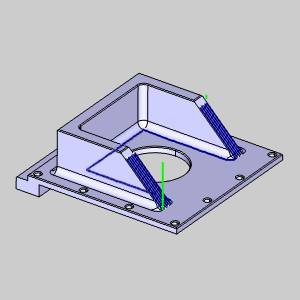
Part 8) Viewing the Animation
The Animation is an excellent way to double check the edits we have made to our toolpath elements.If any issues are noticed in the animation, we can easily undo our edits and make the necessary adjustments.
-
Select the check box for Animation.
The tool appears in the graphics area at the start of our toolpath. -
Use the Animation controls to play through the animation.With either the
 (Solid),
(Solid),  (Transparent), or
(Transparent), or  (Wireframe)view.
(Wireframe)view.
Part 9) Exiting the Edit Toolpath Dialog
Once the Animation has been viewed to ensure no further edits are needed, click OK to finalize and exit the Edit Toolpath Dialog.If you need to change the toolpath to its original state after clicking OK, recompute the operation.
-
Click OK.
The Edit Toolpath Dialog closes.
Important: Once the toolpath of an operation has been edited, the operation will be locked. In the CAM Tree, to the left of the operation name, which will be shown in red font, you will notice a lock icon:  . This ensures the toolpath can not be accidentally recalculated. To return the toolpath to its original state, or to update the operation with the wizard, and recalculate the toolpath, you must first right-click the operation and select Lock/Unlock Operation. The toolpath can then be recalculated to undo the edits that have been made to it with the Edit Toolpath dialog.
. This ensures the toolpath can not be accidentally recalculated. To return the toolpath to its original state, or to update the operation with the wizard, and recalculate the toolpath, you must first right-click the operation and select Lock/Unlock Operation. The toolpath can then be recalculated to undo the edits that have been made to it with the Edit Toolpath dialog.
This concludes this example.






